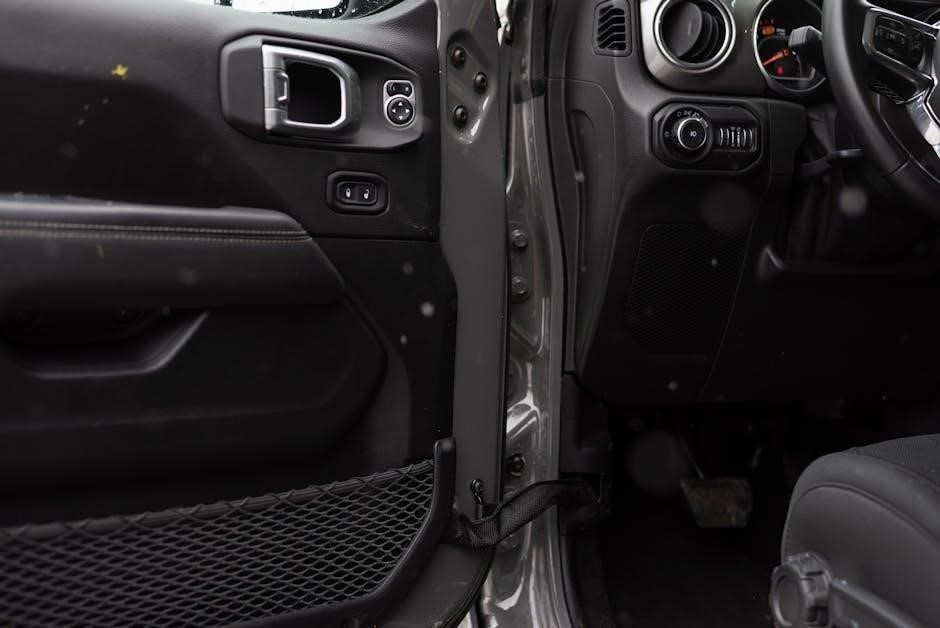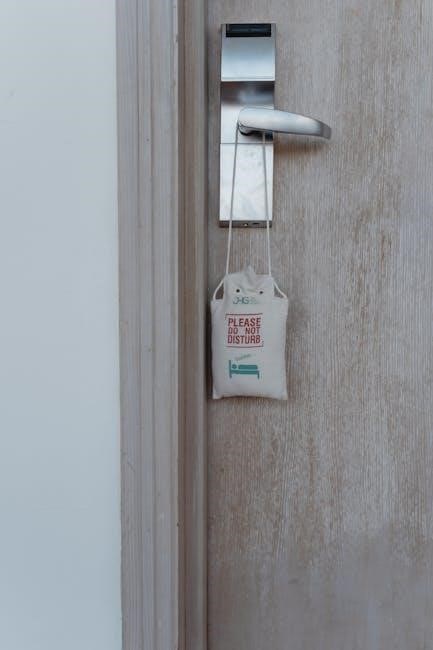Plastic door guides are essential components for smooth sliding door operation‚ ensuring stability and alignment. They are cost-effective‚ durable‚ and offer low friction‚ making them ideal for various applications.
Overview of Sliding Door Mechanisms
Sliding door mechanisms enable doors to move horizontally along a track‚ providing smooth and efficient operation. These systems typically consist of a track‚ rollers‚ and door guides‚ ensuring stability and alignment. The rollers attach to the door‚ while the track is mounted on the frame or ceiling. Door guides help maintain proper positioning‚ preventing derailment. Proper installation and adjustment are critical for seamless functionality‚ ensuring the door glides effortlessly. Sliding mechanisms are widely used in residential and commercial settings due to their space-saving and energy-efficient design.
Importance of Door Guides in Sliding Door Systems
Door guides are crucial for maintaining the alignment and stability of sliding doors‚ ensuring smooth operation. They prevent doors from derailing‚ reducing wear and tear on the system. Guides also minimize friction‚ allowing doors to move effortlessly. By keeping the door properly positioned‚ they enhance safety and prevent accidental movement. Durable guides extend the lifespan of the sliding mechanism‚ reducing maintenance needs. Their role is vital for both functionality and user experience‚ making them an essential component in sliding door systems.

Types of Plastic Door Guides
Plastic door guides come in various types‚ including adjustable‚ fixed‚ and self-lubricating designs. Each offers unique benefits‚ ensuring smooth operation and durability for sliding door systems.
Adjustable Plastic Door Guides
Adjustable plastic door guides offer versatility and precision‚ allowing users to fine-tune the alignment of sliding doors. These guides feature mechanisms that enable horizontal or vertical adjustments‚ ensuring smooth operation and preventing misalignment. Their adaptability makes them ideal for installations where door stability is crucial. Constructed from durable materials‚ they maintain functionality over time‚ providing consistent performance in both residential and commercial settings. This adjustability enhances door longevity and user satisfaction‚ making them a practical choice for various applications.
Fixed Plastic Door Guides
Fixed plastic door guides are designed for consistent and reliable performance in sliding door systems. Unlike adjustable models‚ they are pre-set for specific door alignments‚ offering simplicity and cost-effectiveness. These guides are ideal for lightweight doors or applications where adjustments are unnecessary. Their robust construction ensures minimal wear and tear‚ providing long-term stability. Fixed plastic guides are commonly used in interior doors‚ wardrobes‚ and panel systems‚ where smooth‚ trouble-free operation is essential. They are a practical solution for installations requiring durability and straightforward functionality.
Self-Lubricating Plastic Door Guides
Self-lubricating plastic door guides are designed to reduce friction and ensure smooth door operation without the need for external lubrication. Made from materials like nylon or polyethylene‚ these guides feature inherent lubricating properties‚ minimizing wear and tear. They are ideal for high-traffic areas and applications where maintenance is a concern. Self-lubricating guides are commonly used in residential and commercial settings‚ offering quiet operation and durability. Their ability to handle repeated use without degradation makes them a practical choice for sliding glass doors and heavy-duty sliding systems.

Materials and Durability
Plastic door guides are crafted from durable materials like nylon and polyethylene‚ known for their resistance to wear and tear‚ ensuring longevity and smooth operation in sliding door systems.
Common Plastics Used for Door Guides
Plastic door guides are typically made from high-density polyethylene (HDPE)‚ polypropylene (PP)‚ or nylon. These materials offer excellent durability‚ resistance to wear‚ and low friction‚ ensuring smooth door operation. HDPE is known for its strength and impact resistance‚ while PP provides flexibility and heat resistance. Nylon‚ on the other hand‚ is prized for its high tensile strength and self-lubricating properties‚ making it ideal for sliding mechanisms. These plastics are chosen for their ability to withstand heavy use and maintain functionality over time.
Factors Affecting the Durability of Plastic Guides
The durability of plastic door guides is influenced by environmental factors‚ usage patterns‚ and material quality. Temperature fluctuations and moisture can cause warping or degradation over time. High-traffic areas may lead to increased wear‚ while improper alignment or installation can reduce lifespan. Material quality‚ such as the grade of plastic used‚ also plays a role‚ with lower-quality plastics being more prone to brittleness. Regular maintenance‚ including cleaning and lubrication‚ is essential to extend the life of the guides and ensure optimal performance.

Installation and Maintenance
Proper alignment during installation ensures smooth operation. Regular cleaning and lubrication of guides are essential for maintaining functionality and longevity of sliding door systems effectively.
Step-by-Step Installation Guide
To install plastic door guides‚ start by measuring and marking the track’s position on the door frame. Attach the guide to the door using screws‚ ensuring alignment with the track. Secure the guide firmly‚ then test the door’s movement. Adjust the guide as needed for proper alignment. Regular lubrication of moving parts ensures smooth operation. Always follow the manufacturer’s instructions for specific installation requirements to guarantee optimal performance and durability.
Tips for Maintaining Plastic Door Guides
Regularly clean the guides to remove dirt and debris‚ ensuring smooth operation. Lubricate moving parts with silicone spray to reduce friction. Inspect the guides for wear and tear‚ replacing them if damaged. Adjust the alignment periodically to maintain proper door movement. Avoid using harsh chemicals‚ as they may degrade the plastic. For optimal performance‚ maintain a consistent cleaning schedule and address issues promptly to prevent further damage.
Choosing the Right Plastic Door Guide
Choosing the right plastic door guide involves considering door weight‚ type‚ and usage. Look for adjustable‚ durable options with smooth operation and compatibility with your door system.
Key Considerations for Selection
Selecting plastic door guides requires evaluating factors like door weight‚ size‚ and type. Assess the material’s durability‚ load-bearing capacity‚ and lubrication needs. Compatibility with existing hardware and door frames is crucial. Consider adjustable options for flexibility and ease of installation. Additionally‚ think about environmental factors‚ such as moisture or temperature changes‚ that might affect performance. Prioritize guides that offer smooth operation and low friction to ensure long-term functionality and reduce maintenance needs.
Compatibility with Different Door Types
Plastic door guides are versatile and compatible with various sliding door types‚ including residential‚ commercial‚ and industrial doors. They suit glass‚ wood‚ and metal doors‚ ensuring smooth operation across different setups. Adjustable guides accommodate diverse door weights and sizes‚ while fixed guides offer stability for standard doors. Compatibility with track systems and rollers ensures seamless integration‚ making plastic guides a universal solution for maintaining door alignment and functionality in both light and heavy-duty applications.
Applications of Plastic Door Guides
Plastic door guides are widely used in residential‚ commercial‚ and industrial settings‚ ensuring smooth operation of sliding doors in closets‚ rooms‚ and large industrial spaces efficiently.
Residential Use Cases
In homes‚ plastic door guides are commonly installed in sliding closet doors‚ balcony doors‚ and room dividers. They ensure doors move smoothly‚ reducing noise and wear. Their lightweight yet durable design makes them ideal for frequent use. Homeowners appreciate their easy installation and maintenance‚ making them a practical choice for enhancing both functionality and aesthetics in residential spaces. They also contribute to energy efficiency by maintaining door alignment‚ reducing air leaks‚ and insulating rooms effectively.
Commercial and Industrial Applications
Plastic door guides are widely used in commercial and industrial settings for their durability and reliability. They are ideal for large sliding doors in warehouses‚ hospitals‚ and offices‚ ensuring smooth operation under heavy use. In healthcare facilities‚ they facilitate quiet and efficient movement of doors in patient rooms or operating theaters. Industrial facilities benefit from their low maintenance and resistance to wear‚ making them suitable for high-traffic areas. Their versatility and cost-effectiveness make them a preferred choice for various professional environments.

Advantages of Plastic Door Guides
Plastic door guides offer cost-effectiveness‚ durability‚ and low friction for smooth door operation. They are lightweight‚ easy to install‚ and ideal for both residential and commercial use.
Cost-Effectiveness
Plastic door guides are a budget-friendly solution for sliding doors‚ offering durability without high costs. They are often priced lower than metal or nylon alternatives‚ making them a popular choice for homeowners and businesses. Their affordability allows for easy replacement and maintenance‚ ensuring long-term savings. Additionally‚ plastic guides minimize the need for frequent repairs‚ further reducing overall expenses. This makes them an economical option for enhancing door functionality and longevity.
Low Friction and Smooth Operation
Plastic door guides are designed to minimize friction‚ ensuring smooth and quiet operation of sliding doors. Made from materials like nylon or POM‚ they offer self-lubricating properties‚ reducing wear and tear. This results in effortless door movement‚ enhancing user experience. The low friction design prevents jamming and ensures consistent performance over time‚ making plastic guides ideal for high-traffic areas. Their smooth operation also contributes to extended door and track longevity‚ providing reliable functionality with minimal maintenance requirements.

Comparison with Other Materials
Plastic door guides offer lightweight‚ cost-effective‚ and corrosion-resistant solutions compared to metal‚ providing quieter operation and minimal maintenance‚ making them a durable choice for sliding doors.
Plastic vs. Metal Door Guides
Plastic door guides are lightweight‚ cost-effective‚ and resistant to corrosion‚ offering a quieter operation compared to metal guides. Metal guides‚ while more durable‚ are heavier and prone to rust over time. Plastic guides are ideal for residential use due to their smooth‚ low-friction performance and minimal maintenance requirements. They are also more versatile in design and color options‚ making them a popular choice for modern sliding door systems. Metal guides are better suited for heavy-duty applications where strength and longevity are critical.
Plastic vs. Nylon Door Guides
Plastic and nylon door guides each have unique advantages. Plastic guides are more affordable and come in a variety of colors‚ making them a common choice for residential applications. Nylon guides‚ known for their high durability and self-lubricating properties‚ are ideal for heavy-use scenarios. While plastic may wear faster‚ it offers a quieter operation and easier installation. Nylon‚ though more expensive‚ provides superior resistance to wear and tear‚ making it suitable for commercial settings where longevity is a priority.

Troubleshooting Common Issues
Common issues with sliding doors include misalignment and wear on plastic guides. Regular inspection and adjustment can prevent major repairs‚ ensuring smooth and safe operation.
Fixing Misaligned Sliding Doors
Misaligned sliding doors can cause uneven movement and strain on plastic guides. To fix this‚ adjust the door rollers by loosening screws and realigning them with the track. Ensure the door is level and plumb‚ then tighten the screws. Clean the track to remove debris and apply a silicone-based lubricant for smoother operation. Regular maintenance prevents further misalignment and extends the lifespan of the door system.
Addressing Wear and Tear
Plastic door guides can experience wear and tear over time‚ leading to reduced performance. Regular inspection and cleaning of the track and rollers are essential to remove dirt and debris. Applying a silicone-based lubricant can reduce friction and prevent excessive wear. If damage is noticed‚ replace worn-out guides promptly to maintain smooth door operation. Tightening loose screws and ensuring proper alignment can also help extend the lifespan of the plastic guides. Regular maintenance ensures longevity and optimal functionality.
Safety and Security Considerations
Plastic door guides ensure secure and stable door operation‚ preventing accidental movement. Their load-bearing capacity and durable design enhance safety‚ while proper installation maintains reliability and user protection.
Load-Bearing Capacity of Plastic Guides
Plastic door guides are engineered to withstand significant weight‚ ensuring durability under regular use. Their load-bearing capacity is determined by material quality and design‚ making them suitable for both light and heavy doors. Proper installation enhances their strength‚ while advanced manufacturing techniques improve resistance to wear. This ensures safe and reliable operation‚ maintaining door stability even under stress. The robust construction of plastic guides contributes to their longevity and performance in various environments.
Preventing Accidental Door Movement
Plastic door guides play a crucial role in preventing unintended door movement by securely tracking doors along their path. Features like snug fits‚ anti-jump mechanisms‚ and durable materials ensure doors remain aligned and stable. Additional safety measures‚ such as optional locking systems‚ can further enhance control. These elements work together to minimize the risk of accidental shifts‚ providing reliable performance and peace of mind for users. Regular maintenance of the guides also helps maintain their effectiveness over time.

Environmental and Sustainability Aspects
Plastic door guides contribute to sustainability by reducing waste and promoting energy efficiency through smooth operation. Eco-friendly materials and recyclable options further enhance their environmental appeal and durability.
Eco-Friendly Plastic Materials
Eco-friendly plastic materials for door guides are made from recycled or biodegradable plastics‚ reducing environmental impact. These sustainable options are durable‚ resistant to wear‚ and lightweight‚ ensuring smooth door operation. Energy-efficient and recyclable‚ they align with green building standards‚ promoting a healthier planet while maintaining functionality and performance in sliding door systems.
Recycling Potential of Plastic Guides
Plastic door guides are recyclable‚ contributing to sustainability efforts. Many are made from materials like polypropylene‚ which can be processed in recycling facilities. This reduces waste and helps conserve natural resources. Recycling plastic guides also lowers carbon emissions associated with producing new plastics. Proper disposal and recycling practices ensure these components remain environmentally friendly‚ aligning with eco-conscious values and promoting a greener future.
Plastic door guides provide a reliable‚ cost-effective solution for sliding doors‚ ensuring smooth operation‚ longevity‚ and contributing to eco-friendly practices and sustainable design.
Final Thoughts on Plastic Door Guides
Plastic door guides are a practical and efficient solution for sliding doors‚ offering durability‚ cost-effectiveness‚ and ease of installation. They provide smooth operation and minimize wear‚ ensuring long-term performance. Their versatility makes them suitable for residential‚ commercial‚ and industrial settings. With advancements in materials and design‚ plastic guides continue to enhance door functionality while addressing environmental concerns. They remain a reliable choice for maintaining seamless sliding door operation and user satisfaction in various applications.
Future Trends in Sliding Door Technology
Future trends in sliding door technology are expected to focus on smart home integration and automation. Doors may adjust automatically for better energy efficiency and user convenience. Eco-friendly materials‚ such as recycled plastics‚ could become more prevalent‚ aligning with sustainability goals. Additionally‚ advancements in design may lead to quieter operation and improved durability. These innovations aim to enhance functionality while maintaining aesthetic appeal‚ making sliding doors even more versatile for modern applications.